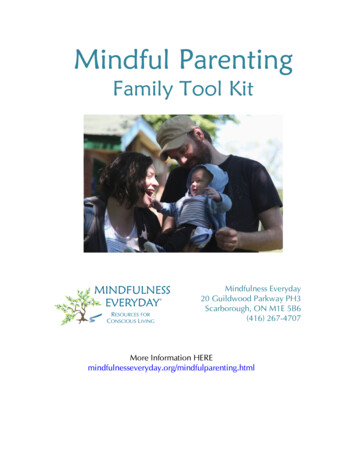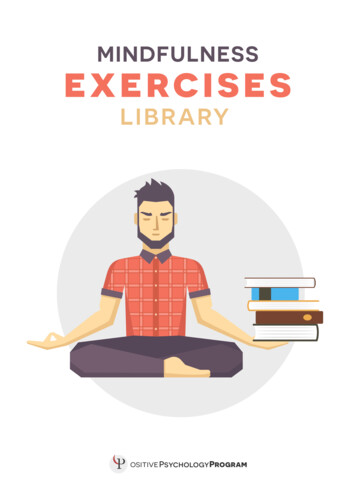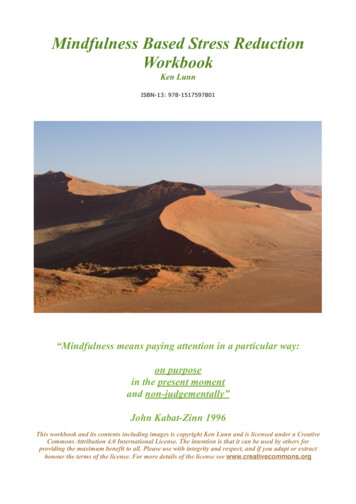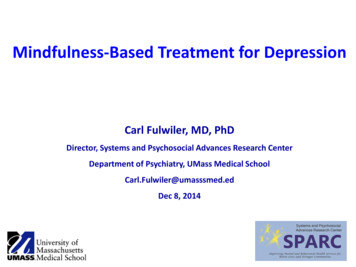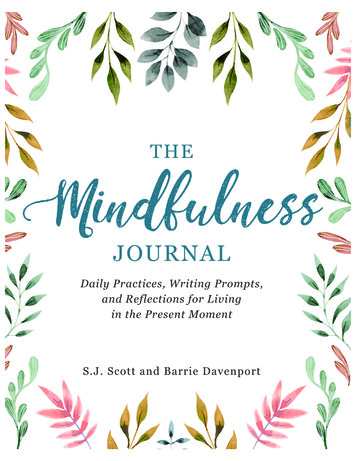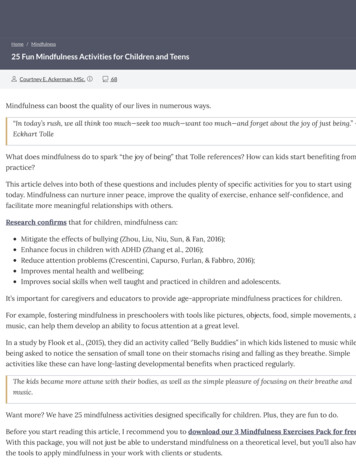
Transcription
Home / Mindfulness25 Fun Mindfulness Activities for Children and Teens Courtney E. Ackerman, MSc. 68Mindfulness can boost the quality of our lives in numerous ways.“In today’s rush, we all think too much—seek too much—want too much—and forget about the joy of just being.” –Eckhart TolleWhat does mindfulness do to spark “the joy of being” that Tolle references? How can kids start benefiting frompractice?This article delves into both of these questions and includes plenty of specific activities for you to start usingtoday. Mindfulness can nurture inner peace, improve the quality of exercise, enhance self-confidence, andfacilitate more meaningful relationships with others.Research confirms that for children, mindfulness can:Mitigate the effects of bullying (Zhou, Liu, Niu, Sun, & Fan, 2016);Enhance focus in children with ADHD (Zhang et al., 2016);Reduce attention problems (Crescentini, Capurso, Furlan, & Fabbro, 2016);Improves mental health and wellbeing;Improves social skills when well taught and practiced in children and adolescents.It’s important for caregivers and educators to provide age-appropriate mindfulness practices for children.For example, fostering mindfulness in preschoolers with tools like pictures, objects, food, simple movements, amusic, can help them develop an ability to focus attention at a great level.In a study by Flook et al., (2015), they did an activity called ‘’Belly Buddies’’ in which kids listened to music whilebeing asked to notice the sensation of small tone on their stomachs rising and falling as they breathe. Simpleactivities like these can have long-lasting developmental benefits when practiced regularly.The kids became more attune with their bodies, as well as the simple pleasure of focusing on their breathe andmusic.Want more? We have 25 mindfulness activities designed specifically for children. Plus, they are fun to do.Before you start reading this article, I recommend you to download our 3 Mindfulness Exercises Pack for freeWith this package, you will not just be able to understand mindfulness on a theoretical level, but you’ll also havethe tools to apply mindfulness in your work with clients or students.
This article contains:4 Fun Mindfulness Activities and Exercises for Children15 Tips for Teaching Mindfulness to Kids and Teenagers8 Mindfulness Games, YouTube Videos, and Apps to Support Your Teachings3 Mindfulness Training Classes For Children with AnxietyThe Basics: Teaching Essential Mindfulness Practices and SkillsMindfulness Meditation for Very Young ChildrenThe Benefits Of Mindfulness In Schools (K12) VideosA Take Home MessageReferences4 Fun Mindfulness Activities and Exercises for ChildrenLet’s start with these simple ways to attune children with their bodies. At a young age, humans naturally curiouabout the strength and flexibility of their bodies. It’s a great age to introduce body-mind awareness as a valuabway to take care of themselves.Mindful PosingOne easy way for children to dip their toes into mindfulness is through body poses. To get your kids excited, tethem that doing fun poses can help them feel strong, brave, and happy.Have the kids go somewhere quiet and familiar, a place they feel safe. Next, tell them to try one of the followingposes:1. The Superman: this pose is practiced by standing with the feet just wider than the hips, fists clenched, andarms reached out to the sky, stretching the body as tall as possible.2. The Wonder Woman: this pose is struck by standing tall with legs wider than hip-width apart and hands ofists placed on the hips (Karen Young, 2017).Ask the kids how they feel after a few rounds of trying either of these poses. You may be surprised.Spidey-SensesWhile on the subject of superheroes, this can be a related “next step” to teach kids how to stay present.
Instruct your kids to turn-on their “Spidey senses,” or the super-focused senses of smell, sight, hearing, taste, atouch that Spiderman uses to keep tabs on the world around him. This will encourage them to pause and focustheir attention on the present, opening their awareness to the information their senses bring in (Karen Young,2017).This is a classic mindfulness exercise and encourages observation and curiosity—great skills for any human topractice.The Mindful JarThis activity can teach children how strong emotions can take hold, and how to find peace when these strongemotions feel overwhelming.First, get a clear jar (like a Mason jar) and fill it almost all the way with water. Next, add a big spoonful of glglue or glue and dry glitter to the jar. Put the lid back on the jar and shake it to make the glitter swirl.Finally, use the following script or take inspiration from it to form your own mini-lesson:“Imagine that the glitter is like your thoughts when you’re stressed, mad or upset. See how they whirl around anmake it really hard to see clearly? That’s why it’s so easy to make silly decisions when you’re upset – because younot thinking clearly. Don’t worry this is normal and it happens in all of us (yep, grownups too).[Now put the jar down in front of them.]Now watch what happens when you’re still for a couple of moments. Keep watching. See how the glitter starts tosettle and the water clears? Your mind works the same way. When you’re calm for a little while, your thoughts sto settle and you start to see things much clearer. Deep breaths during this calming process can help us settle whwe feel a lot of emotions” (Karen Young, 2017).This exercise not only helps children learn about how their emotions can cloud their thoughts, but it alsofacilitates the practice of mindfulness while focusing on the swirling glitter in the jar.Try having the kids focus on one emotion at a time, such as anger, and discuss how the shaken verse settlingglitter is like that emotion.SafariThe Safari exercise is a great way to help kids learn mindfulness. This activity turns an average, everyday walk ian exciting new adventure.Tell your kids that you will be going on a safari: their goal is to notice as many birds, bugs, creepy-crawlies, andother animals as they can. Anything that walks, crawls, swims, or flies is of interest, and they’ll need to focus alltheir senses to find them, especially the little ones (Karen Young, 2017).A similar exercise for adults is the mindfulness walk. This exercise provokes the same response in children thatmindful walk elicits in adults: a state of awareness and grounding in the present.
If you’re interested in more information on how to encourage the practice of mindfulness in children and teensyou can check out the other exercises from this website. Otherwise, head on to the next section where we laykey tips for teaching these concepts.15 Tips for Teaching Mindfulness to Kids and TeenagersWhen you are trying to teach your kids or young clients about mindfulness and its benefit, we recommend youbegin with a few guidelines:1. Make sure they are ready to give mindfulness a try; if they are full of energy and itching to run and play, itnot be the best time for practicing mindfulness for the first time.2. Explain what mindfulness is and what it is not; give examples of what seems similar to mindfulness but is(i.e., introspection or chasing thoughts down the “rabbit hole” versus listening to our bodies).3. Say it in an age-appropriate way, with words they will understand.4. Offer to practice mindfulness with them; sometimes having a model makes all the difference.5. Assure them that it’s okay to get off track, and how to gently guide themselves back to mindfulness when trealize they lost focus.6. Finish the practice by doing something they enjoy with them to ensure they have a positive experience.Megan Cowan, co-founder, and co-director at the Mindful Schools program in Oakland, also has some tips on hto teach mindfulness to kids (2010):1. Keep the purpose of mindfulness practice in mind. Be sure to engage in mindful practice with children inpositive situations, and never use it as a disciplinary tool.2. Make sure you practice mindfulness yourself!3. Set a daily routine for practicing mindfulness to make sure you incorporate it.4. Prepare the environment for successful practice; move the furniture around or have everyone switchpositions.5. Involve students in the process; perhaps designate a different child each day to alert the class when it’s timto practice mindfulness or help set up any tools or props.6. Share your own experiences with the kids; this will help them understand how mindfulness is applied andpracticed in everyday life. Feel free to share how you redirect yourself when you feel distracted during amindfulness session.7. Encourage the children to share their experiences as well, whether they were good experiences withmindfulness or experiences in which they got distracted. Maybe each session can end with a few studentssharing how it went for them.8. Practice every day. The more you embed mindfulness into the daily routine, the easier it is to engage.
Cowan (2010) also includes a short script if you’d like to use her mini-lesson.Relay the following instructions to your kids:“Please get into your mindful bodies–still and quiet, sitting upright, eyes closed.”“Now place all your attention on the sound you are about to hear. Listen until the sound is completely gonRing a “mindfulness bell,” or have a student ring the bell. Use a bell with a sustained sound or a rainstick toencourage mindful listening.“Please raise your hand when you can no longer hear the sound.”When most or all have raised their hands, you can say, “Now slowly, mindfully, move your hand to yourstomach or chest, and just feel your breathing.”You can help students stay focused during the breathing with reminders like, “Just breathing in justbreathing out ”Ring the bell to end.For more in-depth tips and ideas on teaching mindfulness to children, check out the book Planting Seeds:Practicing Mindfulness with Children by Thich Nhat Hanh and the Plum Village Community.The website from editor and children’s book author Annaka Harris also provides some great ideas for exercisethat teach mindfulness to children.8 Mindfulness Games, YouTube Videos, and Apps to Support Your TeachingsTechnology offers learning and development for these practices. To ensure that you are using technology to yoadvantage when it comes to teaching children mindfulness, give some of these resources a try.Mindfulness for Children: Meditations for KidsThis is an application that can be downloaded through the Android app store, iTunes, Google Music, or the Appapp store. Multiple versions are available. There are a few versions that must be purchased and one free versionwhich offers fewer conveniences than the paid versions.This app is centered around guided meditation. It is designed to help children relax before bed. Nature soundsinstructions start the sessions. The app can guide the user through a body scan, visualizations, and breathingexercises.Reviews for this app have been positive and the developers report that parents have seen a reduction in ADHDsymptoms by using this app.For more information or to give this app a try, visit the website.Smiling Minds App
Another application that is popular for children as young as seven is the Smiling Mind app. This app is availablethrough the Apple app store as well as the Google Play store. It is free to download and use.This app offers similar features to the Mindfulness for Children app, including a body scan activity. There aredozens of modules with hundreds of sessions available, each customized for well-being, education, and theworkplace (for adults).If you’d like to check out the reviews for this app or learn more about it, visit the website.Still Quiet PlaceIf you’d like to use a video to help your kids learn how to practice mindfulness, the “Mindfulness Exercises for KStill Quiet Place Video” is a great resource. This animated video can help students learn how to go to a “still quiplace.”Check out the video here, and scroll down to the link below the video to see more activities from GoZen.com.Mindfulness Exercises for Kids: Still Quiet Place (GoZen!)Mindfulness Games for KidsSeveral interactive games are available on the Kids Activities Blog. Here are just a few:1. Blowing bubbles. Have your kids focus on taking in a deep, slow breath, and exhaling steadily to fill the bubEncourage them to pay close attention to the bubbles as they form, detach, and pop or float away.2. Pinwheels. Use the same tactics from blowing bubbles to encourage mindful attention on the pinwheels.3. Playing with balloons. Tell your kids that the aim of this game is to keep the balloon off the ground, but hathem move slowly and gently. You can tell them to pretend the balloon is very fragile if that helps.4. Texture bag. Place several small, interestingly shaped or textured objects in a bag. Have each child reach inand touch an object, one at a time, and describe what they are touching. Make sure they don’t take the objout of the bag, forcing them to use only their sense of touch to explore the object.5. Blindfolded taste tests. Use a blindfold for each child and have them experience eating a small food, like a
raisin or a cranberry, as if it was their first time eating it.If you want to know about more games you can play with children to teach them about mindfulness, check outbook Mindful Games: Sharing Mindfulness and Meditation with Children, Teens, and Families by Susan KaiserGreenland.3 Mindfulness Training Classes For Children with AnxietyMindfulness practice can be an especially important component of a child’s life if they suffer from anxiety.Learning about mindfulness and how to engage in mindfulness can help a child realize that worrying is normal,there are useful coping methods when we are worrying too much.Aside from the Mindful Schools program mentioned earlier, there are classes and programs designed especiallychildren, and even a few that are structured for children with anxiety.1. The “Wellness Works in Schools” course is one such class, which has been shown to result in increased selregulation and executive function (Garey, 2017).2. The Hawn Foundation’s MindUP curriculum is also a useful tool for teaching mindfulness to children (Gare2017). These courses can help children learn how to manage their stress as they grow up.3. There is also a popular course called “MonkeyMind and Me: A Mindfulness Course for Children.” Childrenlearn how to meditate and practice mindfulness over eight one hour sessions held over eight weeks. Thelessons are delivered through stories about MonkeyMind, a friendly puppet who has trouble with self-regulation (“MonkeyMind and Me”, 2017). The course includes lessons, opportunities to practice, design ofhomemade project, and a graduation ceremony.The structure of these lessons and exercises transforms teaching mindfulness into an experience everyone migenjoy—and benefit from.The Basics: Teaching Essential Mindfulness Practices and SkillsBefore you delve into the classroom, review these basic skills and you may have better success with students aclients learning mindfulness.Mindful BreathingMindful breathing is a staple of practicing mindfulness. It is the foundation of many other exercises. To help kidlearn how to engage in mindful breathing, you can use a video like the one below:
Breath Meditation for Kids Mindfulness for KidsThis video guides children through a breathing meditation by instructing them to imagine a sailboat that risesfalls as they breathe; with each inhale and exhale, the boat moves gently on top of the water.They also get an opportunity to visualize their breath with a color and focus on the experience of their breathmoving through their nostrils. Lastly, the video ends with the exercise of the children imagining (with their eyeclosed) that they used to be a fish and paying attention to how it would feel to breathe through their lungs for tfirst time.Body ScanThe body scan is a key practice in mindfulness, and an easy one to teach to children.Have your kids lie down on their back on a comfortable surface and close their eyes;Then tell them to squeeze every muscle in their body as tight as they can. Tell them to squish their toes anfeet, squeeze their hands into fists, and make their legs and arms as hard as stone;After a few seconds, have them release all their muscles and relax for a few minutes;Encourage them to think about how their body is feeling throughout the activity (Roman, 2015).This simple exercise gets kids to be more aware of their bodies and helps them find a way to be present in themoment.Heartbeat Exercise
Paying attention to one’s heartbeat has a role in many mindfulness exercises and activities. To begin, tell your kto jump up and down in place or do jumping jacks for one minute.When they have finished, have them sit down and put a hand over their heart. Instruct them to close their eyespay attention only to their heartbeat and, perhaps, their breath as well (Roman, 2015).This exercise teaches children to notice their heartbeat, and use it as a tool to help their focus. These skills willcome in handy as they start engaging in more advanced mindfulness activities.Mindfulness Meditation for Very Young ChildrenYou might be thinking that these tips and exercises are great for elementary or middle school students, but lesrealistic for young children. This section focuses on children who are toddlers through kindergarten graduatesOne mother explained laid out her five strategies for teaching young children mindfulness—starting with herthree-year-old child learning mindfulness.Her strategies are:Teach kids to recognize and identify their own emotions. Children need to associate the word or term foremotion with the actual experience of feeling that emotion. Encourage them to think about how each emofeels in their body. Does anger feel like they’ve got steam coming out of their ears? Does love make them flike their heart is going to burst open?Validate their emotions. Children often respond with frustration or sadness when told that their pain,however trivial it seems to us, is “not a big deal.” When teaching mindfulness, let kids feel their feelingswithout fear of judgment. Focus instead on teaching them tools to listen to their emotions.Teach kids mindful breathing strategies. As we noted above, mindful breathing is a building block in allmindfulness practices. Children benefit from focusing on their breathing when confronted with emotionsare hard to manage.The author of the blog laid out three techniques she has put to use with her children:1. Noticing the breath: this involves simply paying attention to what breathing actually feels like.2. Five-finger starfish meditation: this breathing technique has kids holding up one hand in a starfish position(fingers spread wide) while they gently trace up and down each finger with the other hand, focusing on regularbreathing at the same time.3. Counting the breath: this technique is what it sounds like: have your children pause and count their breaths.breath in is “1”, the next breath out is “2,” etc. You can have them count to 10 if they’re very young, or slightly higdepending on their abilities.
Lead them in a guided meditation. Use a script or an exercise or app like the ones described above forthis meditation.Practice what you preach. As we mentioned earlier, it is so important to actually “do as you say.” Kids areintuitive and human nature encourages mimicry, two advantages we can harness when trying to teach (Be“Baby Buddhas.”)Guide your kids every step of the way, but make sure you are taking those steps yourself as well. It will makeeveryone’s practice richer.The Benefits Of Mindfulness In Schools (K12) VideosChildhood and adolescence are important developmental stages that will construct the groundwork for mentalhealth in the adult developmental stage.In recent literature, mindfulness-based school programs have demonstrated a range of social, cognitive, andemotional benefits for elementary and middle-school students.Cognitive BenefitsExecutive function is a set of mental skills that constitutes attention, switching focus, planning, organizing andremembering details. Research in education suggests that mindfulness practice can lead to improvements inexecutive function in children.For instance, in the study of Flook et al., (2010) conducted on 3rd graders, students who went through an 8-weemindfulness program showed improvements in behavioral regulation, metacognition and focus compared to thcontrol group who did not have the mindfulness program.In another study, students who had a 24-week of mindfulness training scored higher in attentional measures intheir elementary school (Napoli et al., 2004). Additionally, a study on preschoolers emphasized that children whwent through a mindfulness curriculum for 12 weeks earned higher marks on academic performance measures
They also showed greater improvements in areas that predict future success (Flook et al., 2015).Social BenefitsA social skill is any skill that we use to interact and communicate with others.Deficits and excesses in social behavior can affect learning, understanding, and classroom climate. Recent reseon lower-income and ethnic minority elementary school children highlighted how a 5-week mindfulnesscurriculum can lead to better participation in activities, as well as nurture a classroom culture of mutual respeand care in 9th-grade students (Black et al., 2013).Emotional BenefitsEmotional health, which is a positive sense of well-being, is an important component of child and adolescentdevelopment. Emotional problems such as anxiety, stress, and depression can affect self-esteem, performanceand social interactions.Mindfulness practice may facilitate the ability to manage stress, and also lead to deeper well-being in studentsAccording to one study by Schonert-Reichl and his colleagues (2010), mindfulness practice leads to higher scoron self-report measures of optimism and positive emotions in elementary school students.Moreover, in a study conducted by Wall (2005), self-reported findings showed preteens feeling calmer, with anenhanced experience of well-being—and improved sleep—after a 5-week modified mindfulness-based stressreduction program.Videos on Mindfulness in SchoolsThese four videos can help students open their minds to the benefits of mindfulness. We recommend pairing aof these segments with a discussion.Questions for after the selected clip can include, “Has anyone practiced mindfulness, and how has it gone for yor “What do you think is the reason most people do not practice mindfulness, and how can we start changingthis?”
Mindful Schools In-Class InstructionSanjay Gupta MD: Teaching mindfulness in schoolsMindfulness in Schools: Richard Burnett at TEDxWhitechapel
Mindfulness in Education, Learning from the Inside Out: Amy Burke a A Take-Home MessageResearch confirms that mindfulness can improve mental health by aiding well-being, attention, self-regulationand social competency. It just needs to be practiced—and encouraged.Mindfulness-based programs in schools can have a life-long impact on the psychological, social, and cognitivewell-being of children and teens. Even at home or with clients, how can you incorporate mindfulness into yourteachings and own schedule?Do you have kids or work with kids on a regular basis? Try these tips and activities out, and let us know how thworked in the comments section below.Good luck, and remember this old saying:Tell me and I forget. Teach me and I remember. Involve me and I learn.ReferencesWas this article useful to you?NoYesAbout the AuthorCourtney Ackerman, MSc., is a graduate of the positive organizational psychology and evaluation program atClaremont Graduate University. She is currently working as a researcher for the State of California and herprofessional interests include survey research, well-being in the workplace, and compassion.
CommentsCheryll E. on 17th March 2020 at 7:48 pmLoved the ideas! Look forward to using with my students.ReplyCristina on 5th March 2020 at 6:44 pmLoved the ideas to be used with my little students. ThanksReplyBrian on 21st September 2019 at 11:51 amPost more! Seriously, I am really digging what you have written so far. I’ve scanning your blog right now for more things to reaReplySiobhan on 25th July 2019 at 2:33 pmThank you, Amy! When I see you’ve written an article I go straight to it. Easy to read, concise, informative. You are gifted and Ireally appreciate you taking the time to research, write and share. May your generosity come back to you tenfold.ReplyAsma Jarrar on 22nd July 2019 at 1:23 amThank you so much ,this was a helpful article ! May god reward you for your kind efforts.ReplyKristen Dykeman on 13th July 2019 at 3:42 pmSuch an easy, FREE way to help students and educators just breathe! These idea are very accessible and need to be implemeinto our classrooms. The resources show how simple it would be to make a large, positive impact.Replyprachi sarode on 12th July 2019 at 2:20 pmWonderful article for students in schools.Reply
aliy on 6th June 2019 at 2:37 pmwonderful ideas and easy to follow and clear languageReplyaliye on 6th June 2019 at 11:32 amGreat ideas. I found it very easy to read and have been inspired a lot better than some other therapy websites.Replynazima on 30th May 2019 at 4:35 pmInteresting ideas which can be used in a classroom.Loved the article.ReplyLoad More CommentsLeave a ReplyYour email address will not be published. Required fields are marked *Name *Email *Save my name and email in this browser for the next time I commentPost Comment
Mindfulness18 Mindfulness Games, Worksheets and Activities for KidsMindfulnessTop 50 Best Mindfulness Books (Reviews PDF’s)Mindfulness20 DBT Worksheets and Dialectical Behavior Therapy SkillsMindfulnessHow Does Acceptance And Commitment Therapy (ACT) Work?
MindfulnessWhat is Mindful Yoga? 4 Poses Yoga RetreatsMindfulnessTop 14 Apps For Meditation and Mindfulness ( Reviews)MindfulnessHistory of Mindfulness: From East to West and Religion to ScienceMindfulness60 Benefits of Yoga for Mental & Physical HealthCategories
Body & Brain (25)Coaching & Application (35)Compassion (26)Emotional Intelligence (22)Gratitude (17)Happiness & SWB (29)Meaning & Values (17)Meditation (15)Mindfulness (34)Motivation & Goals (25)Optimism & Mindset (23)Positive CBT (14)Positive Education (16)Positive Emotions (18)Positive Psychology (24)Positive Workplace (18)Relationships (21)Resilience & Coping (32)Software & Apps (17)Strengths & Virtues (14)The Self (44)Theory & Books (24)Therapies (45)
LegalDisclaimerTerms and ConditionsRefund PolicyPrivacy PolicyCompany DetailsAboutChamber of Commerce (KvK)Registration Number: 64733564Taxation (VAT) Number: lein 166229HN MaastrichtThe Netherlandsinfo@positivepsychology.comSign up and download toolsYour first nameYour email address- Your Expertise -
Download PDF
Dec 18, 2017 · For more in-depth tips and ideas on teaching mindfulness to children, check out the book Planting Seeds: Practicing Mindfulness with Children by Thich Nhat Hanh and the Plum Village Community. The website from editor and children’s book author Annaka Harris also provides some great ideas for exerc
